|  
 
 
 | | | | 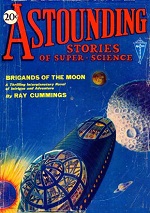

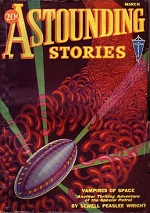

| | Astounding’s The Readers’ Corner
edited by Harry Bates
First letters column: Astounding Stories of Super Science, Mar 1930

 Before modern-day blogs and online fora, before Astounding Science Fiction’s Brass Tacks letters’ column, there was The Readers’ Corner of Astounding Stories of Super Science, where at the leisurely pace of once a month, readers vehemently mixed it up about all topics—including time travel. Before modern-day blogs and online fora, before Astounding Science Fiction’s Brass Tacks letters’ column, there was The Readers’ Corner of Astounding Stories of Super Science, where at the leisurely pace of once a month, readers vehemently mixed it up about all topics—including time travel. Dear Editor: Thus far the chief objection to time traveling has been this: if a person was sent back into the past or projected into the future, it would be possible for said person to interfere most disastrously with his own birth. —Arthur Berkowitz, 768 Beck Street, Bronx, N.Y. (Mar 1932) Dear Editor: Thus far the chief objection to time traveling has been this: if a person was sent back into the past or projected into the future, it would be possible for said person to interfere most disastrously with his own birth. —Arthur Berkowitz, 768 Beck Street, Bronx, N.Y. (Mar 1932)

Dear Editor: I write this letter to comment, not on the stories, which satisfy me, but on a few letters in the “Corner” of the March issue; especially Mr. Berkowitz’ letter. . . . Since he brought up the question of the time-traveler interfering disasterously with his own birth, I will discuss it. . . . Back he goes into time and meets his grandfather, before his father’s birth. For some reason John kills his grandfather. —Robert Feeney, 5334 Euclid, Kansas City, Mo. (Jun 1932)

Dear Editor: I read and enjoyed Mr. Feeney’s interesting letter in the June issue, but wish to ask: Why pick on grandfather? . . . This incessant murdering of harmless ancestors must stop. —Donald Allgeier, Mountain Grove, Mo. (Jan 1933) 
| |
| | | | |

 | | | | 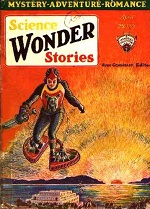 | | “An Adventure in Time”
by Francis Flagg
First publication: Science Wonder Stories, Apr 1930

When a small time machine appears in Professor Bayers’s lab, he builds a larger copy and travels to the future, which is ruled by Amazon women. | |
| | | | |

 
 | | | | 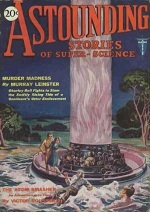

| | “The Atom-Smasher”
by Victor Rousseau
First publication: Astounding, May 1930

We've got the evil Professor Tode who modifies an atom-smasher into a time machine that travels to the paleolithic age and Atlantis, a fatherly older professor, his beautiful young daughter (menaced by evil Tode), casually written racist pronouncements (by Rousseau), and our hero scientist, dashing Jim Dent. But my favorite sentence was the brief description of quantum mechanics, which I didn’t expect in a 1930 science fiction tale. The Planck-Bohr quantum theory that the energy of a body cannot vary continuously, but only by a certain finite amount, or exact multiples of this amount, had been the key that unlocked the door. The Planck-Bohr quantum theory that the energy of a body cannot vary continuously, but only by a certain finite amount, or exact multiples of this amount, had been the key that unlocked the door. 
| |
| | | | |

 
 | | | | 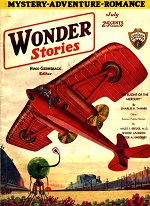 | | “The Time Valve”
by Miles J. Breuer
First publication: Wonder Stories, Jul 1930

In an earlier story (“The Fitzgerald Contraction”), survivors of the sinking of Mu (or Mo, as they called it) travel into space at relativistic speeds only to return to Earth some 200,000 years later. That, of course, is mere time dilation rather than time travel; but in this sequel, the Moans along with present-day beauty Vayill continue even further into the Earth’s future where trouble ensues until Vayill’s aged father comes to the rescue with a real time machine in an airplane. | |
| | | | |

 | | | | 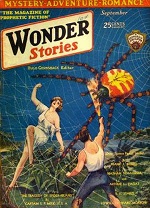 | | The 20,000 A.D. Stories
by Nat Schachner and Arthur Leo Zagat
First story: Wonder Stories, Sep 1930

Tom Jenkins heads into the “Vanishing Woods” to prove that there’s nothing dangerous about them, but he doesn’ return until six months later, and he refuses to talk about where he’s been and what he’ seen—but fortunately for us, the titles of the two Wonder Story stories (“In 20,000 A.D.” in Sep 1930 and “Back to 20,000 A.D.” in Mar 1931) gives us a big clue, although it doesn’t tell us that the world he visits is divided into cold-hearted Masters and their four-armed, giant human Robots.

The use of the word “robot” had not yet evolved from Čapek’s meaning of a humanoid laborer to the modern usage as a purely mechanical being. True, he says, the Masters are far advanced, an’ able to do lots o’ thingsas a result. They’ve learnt everything there was to be learnt, they can live on the earth, in the air, in the water, or underground; they can travel to the other stars; they know how the world come about an’ when it’s ending, they think great thoughts an’things I couldn’t even understand, but, he says, what about the Robots? True, he says, the Masters are far advanced, an’ able to do lots o’ thingsas a result. They’ve learnt everything there was to be learnt, they can live on the earth, in the air, in the water, or underground; they can travel to the other stars; they know how the world come about an’ when it’s ending, they think great thoughts an’things I couldn’t even understand, but, he says, what about the Robots? 
| |
| | | | |

 
 
 
 
 | | | | 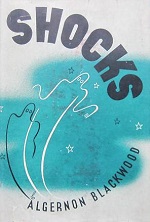 The story also appeared in this 1935 collection. The story also appeared in this 1935 collection. | | “The Man Who Lived Backwards”
by Algernon Blackwood
First publication: World Radio (broadcast guide), 12 Dec 1930

Professor Zeitt posits that all of time always exists and he should be able to break the usual serial traversal of time in order to influence his earlier self to not get into a bad marriage. | |
| | | | |

No Time Travel. Move along. |
“Phantoms of Reality” by Ray Chandler, Astounding, Jan 1930 [parallel universes ]

The Royal Four-Flusher by Arthur Hurley (Murray Roth, director), 16 May 1930 [secondary world ]
 Sadly, I haven’t found a copy of this early talkie with possible, but unlikely, time travel. I say “unlikely” because the hero is transported to a land of kings and queens and fair maidens, but it could be a fantasyland as much as a time in the past. According to imdb, the soundtrack included “Here We Are”, although that song was also sung earlier by Annette Hanshaw for a 1929 animated film, Sita Sings the Blues. Sadly, I haven’t found a copy of this early talkie with possible, but unlikely, time travel. I say “unlikely” because the hero is transported to a land of kings and queens and fair maidens, but it could be a fantasyland as much as a time in the past. According to imdb, the soundtrack included “Here We Are”, although that song was also sung earlier by Annette Hanshaw for a 1929 animated film, Sita Sings the Blues.

Just Imagine by Buddy G. DeSylva, Lew Brown, et. al. (David Butler, director), 23 Nov 1930 [long sleep ]

| |     |